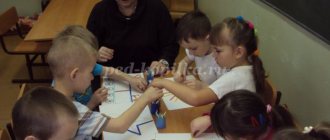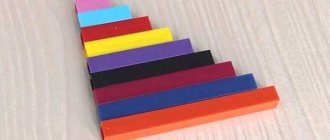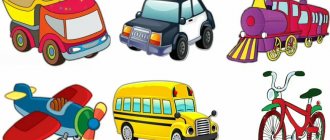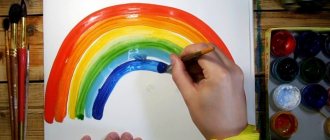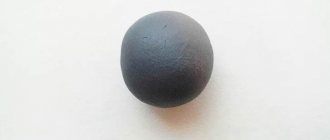The advantage of the Cuisenaire Rod technique
With chopsticks it is convenient to perform a lot of different tasks and exercises, even sometimes not related to mathematics. As I mentioned above, they can be used to develop creativity, ideas about color, etc.
Thus, not a single child with Cuisenaire sticks will definitely get bored. I’ll tell you a secret, they really help me cope with various stressful life situations. You start working with them, and immediately all the anxious thoughts disappear somewhere. And before you there is an opportunity to create and be surprised, admire and rejoice.
Games and exercises for children 5-7 years old
For middle-aged and older preschoolers, classes become more complex, since they are expected to have fairly stable knowledge. Therefore, the games will be aimed at solving developmental problems:
1. Development of mental processes: spatial thinking, imagination, fine motor skills:
- create a flat picture from blocks using geometric shapes;
- create a three-dimensional structure from bars: a well, a house, a fortress;
- build a labyrinth or picture according to the proposed scheme. The child immediately sees the results of his work, while not only basic thinking and memorization skills are formed, but also a sense of beauty, a love of aesthetics and artistic expression. For example, it could be flowers; images of people and animals; objects of inanimate nature;
- Place the pieces on the table according to the instructions (put the red one on the table, place the green one to the right of it);
- retell the folk tale “Zayushkina’s hut” and build houses for each of the heroes (make the fox’s ice house from sticks in cold colors, and the wooden hare’s house from warm colors);
- transfer a figure from a plane into space (build it according to a drawn layout);
- find in the room all the objects equal to the orange bar, objects of the same color;
- Place the blocks on the lined sheet in accordance with the color and size specified in the drawing;
- build a house: on a piece of a certain length you need to put two smaller ones so that they coincide in length, and thus “build” the walls, then put other sticks across them as a roof.
2. Memorizing colors:
- fold a “train” consisting of block cars into a colored stripe in a certain sequence (for example, so that the green car is to the right of the red one, but to the left of the yellow one);
- from the same shades of bars, assemble a “family” of three little men, build a house for each of them with the conditions that the largest man will live only in the yellow house, etc.;
- arrange all the bars of one “family” in order from the brightest to the palest color;
- take out a block of the dictated color from the box where the set is located;
- using the method of elimination, guess the block based on its characteristics, asking closed questions to which the answer will be yes or no.
3. Mastering the natural series of numbers, the concepts of more, less, equal:
- sequentially arrange the sticks according to their color and length;
- build a ladder from bars from a larger number to a smaller one and vice versa, and then “walk” along this ladder with your fingers, calling out the numbers passed;
- put suitable blocks in place of the missing numbers on the street shown on a piece of paper (the street is divided in half by a road, on one side of which there are even houses, and on the other - odd ones);
- place three orange Cuisenaire sticks parallel to each other, and four of the same color on the right, and determine which of the resulting figures is wider than the others and which is the narrowest;
- How much shorter is the pink block than the blue one? Which one could fit between them?
- find the missing step in the staircase;
- determine which part is the longest and check this by superimposing it on the others;
- take as many sticks as possible in your right and left hands, and then count in which hand the sum of the numbers was greater;
- lay out a square from four white cubes, then remove one of the bars of the figure; determine which part of the cube is larger - a quarter or a half;
- name all the sticks longer than the red one and shorter than the blue one.
4. Mastering computational actions:
- from several identical sticks, make the same length as black, yellow, burgundy;
- do the same thing, but from several different sticks;
- designate sticks for money (red is equal to two conventional units, blue - three) and buy different items in the room, counting how much money is in the “budget” and how much things cost;
- with your eyes closed, pick up several sticks, then count their sum and replace two of them with one so that the value of the sum does not change;
- make up each of the numbers from eleven to twenty from sticks;
- with your eyes closed, pull out a pair of sticks of different lengths and determine the color of the second, if the first is blue;
- measure the length of a book, pencil, table using sticks;
- master addition. If you put a red block and a blue and white block next to it, you will get segments of the same length (4=3+1). Gradually complicate the tasks, add examples in which one of the two sticks has disappeared, that is, examples of subtraction.
Description of the set "Cuisenaire's Wands"
Sticks are not always and not exactly sticks. They're like little blocks, or even cubes if they're short. The size of the sticks is from 1 to 10 cm. In terms of quantity, there are simpler sets, including 116 sticks, and there are traditional classic sets with 241 sticks.
They are painted in 10 colors of different shades. For full-fledged lessons with a child, I prefer to choose a set with more sticks.
Games with Cuisenaire sticks for children from 3 to 5 years old
For older children, such aids as:
- A set of games “On the Golden Porch” for children from 3 to 9 years old.
- Game developmental situations for children 3-4 years old “Fun colored numbers”.
- Album-game “House with a bell” for children from 3 to 5 years old.
These manuals will teach children to compare objects by length, width, location in space; identify and name the numerical values of colored sticks; master counting; find signs of similarities and differences between objects; generalize by color, quantity, number.
- Anechka, Malvina and Pinocchio came to visit us today. Oops, something happened to their clothes. Anya, they are asking you to help them. Please decorate their clothes with colorful sticks.
- Oh, what cute boys. Let's see who is the tallest and who is the shortest. We measure their height using magic wands.
A manual with game development situations for children 3-4 years old “Fun Colored Numbers”, in addition to interesting cards, includes multi-colored stripes, divided into squares of the same colors as Cuisenaire’s sticks. These strips can be cut out and used instead of sticks.
- Anechka, let's build a square rug for a cat and a kitten. Just be careful. A kitten mat should be small, and a cat mat should be large.
Triangles
Goal: consolidation of counting within 3, spatial orientation skills.
Children are offered three sticks of red, yellow and blue colors. The teacher gives the task to build triangles from sticks of the same color. Next, we count the triangle by number and order:
- how many triangles?
- which is red (yellow, blue);
- which triangle is in the center (right, left).
The task can be complicated and offer children specific tasks: make a yellow triangle in the center, blue on the right, red on the left, etc.
Picture frames
Goal: learning to correlate objects by size.
Children are given sticks of different colors within 4. Children play artists, they lay out picture frames on the table. To do this, a picture is selected and a frame is made from sticks around it. It is important that children correlate the size of the picture and the size of the sticks. You can count the number of sticks and fix the names of the colors. As a complication, it is proposed to use two short sticks, two long ones each - so that the frames are not square, but rectangular. We count the sticks again and fix the composition of the number 4.
Birdhouses
Goal: strengthen the score within 5, the ability to transform objects.
Children are given sticks: 2 yellow, 2 red, 2 blue, 1 black and 1 white. The teacher suggests building (folding) a house out of sticks. To do this, we first remember how many walls there are, where the floor and ceiling are, what should be the same length (floor and ceiling, walls), what kind of roof there is. Children make a house so that the base is a square.
The teacher makes a riddle about the birdhouse and shows the drawing. He suggests changing the house so that it becomes a birdhouse (shortening the floor and ceiling). We count the sticks and compare the lengths.
Games with Cuisenaire sticks for children from 2 to 3 years old
For games with kids, the following aids are ideal:
- Album-game “It's fun to play together” for children from 2 to 3 years old.
- Album-game “Magic paths for the little ones” (from 2 to 3 years old).
Kids will be able to lay out simple images using sticks, as well as get acquainted with basic colors and concepts such as “one - many”, “high - low”.
- Anya, look who came to visit us today. So this is a real centipede. A centipede hurries along the blue path. And to make it convenient for her to crawl, let’s build her a path out of sticks.
- Anya, our mouse friends are in trouble. The cunning cat Vaska is hunting for them. Let's quickly hide the mice in the houses. To do this, we will close the houses with our miracle wands, and the evil cat Vaska will not be able to find the mice. Close the windows quickly - you will save the mice from the cat.
Snake
Goal: to consolidate the concepts of “one” and “many”, the ability to compose a group of objects.
For the game, sticks of two colors are used: pink and blue (4 each). Children are invited to lay out two snakes with their heads raised (blue and pink); for this, three sticks are placed horizontally and one vertically. We suggest comparing the snakes by length, run your finger along the sticks and determine which one is longer.
How can you practice with Cuisinaire sticks:
- Just a game at the beginning stage. Children sort through them, arrange them in different ways and simply play with them like ordinary cubes, learning, through games and activities, color, size and shape.
- Using them as analogues of numbers for comparison, indicating the difference between them. The child clearly senses the difference between the concepts of more and less.
- Operate with sticks to indicate addition and subtraction operations. Here, sticks are used as a visual aid to teach concepts from an elementary math course.
- Play with sticks and lay them out like a mosaic. At the same time, learn their numerical values and the possibility of comparing them as analogues of numbers.
- Gradually lead to the idea of arithmetic operations, which, with the visual help of tactile and visually familiar objects, become much more accessible to their understanding.
There are many ways to practice with Cuisinaire sticks.
For example, with children aged two to four years old, you can play as follows:
- Let's get acquainted with chopsticks. Together with your child, look at, sort through, touch all the sticks, tell them what color and length they are.
- We lay out paths, fences, trains, squares, rectangles, pieces of furniture, various houses, garages from sticks on a plane.
- We lay out a ladder of 10 Cuisenaire sticks from smallest to largest and vice versa. Walk your fingers along the steps of the ladder, you can count out loud from 1 to 10 and back.
- We lay out the ladder, passing 1 stick at a time. The child needs to find a place for the missing sticks.
- You can build three-dimensional buildings from sticks, like from a construction set: wells, turrets, huts, etc. Arrange the sticks by color and length. “Find a stick the same color as mine. What color are they?" “Put down the same number of sticks as I have.” “Lay out the sticks, alternating them by color: red, yellow, red, yellow” (later the algorithm becomes more complicated).
- Lay out several Cuisenaire counting sticks, invite the child to memorize them, and then, while the baby is not looking, hide one of the sticks. The child needs to guess which stick has disappeared.
- Lay out several sticks, invite the child to remember their relative positions and swap them. The baby needs to return everything to its place.
- Place two sticks in front of the child: “Which stick is longer? Which one is shorter? Place these sticks on top of each other, aligning the ends, and check.
- Place several Cuisenaire sticks in front of the child and ask: “Which is the longest? Which is the shortest?
- The task is to find any stick that is shorter than the blue one and longer than the red one.
- Place the sticks into 2 piles: one has 10 pieces, and the other has 2. Ask where there are more sticks and by how many.
- The task is to show the stick so that it is not yellow (not red, etc.).
- Ask to find 2 absolutely identical Cuisenaire rods. Ask: “How long are they? What color are they?"
- Build a train from cars of different lengths, from the shortest to the longest. Ask what color the carriage is fifth or eighth. Which carriage is to the right of the blue one, to the left of the yellow one. Which carriage is the shortest, the longest? Which carriages are longer than the yellow one, shorter than the blue one.
- Lay out several pairs of identical sticks and ask the child to “put the sticks in pairs.”
- From several sticks you need to make one the same length as burgundy and orange. From several identical sticks you need to make one the same length as the orange one. How many white sticks can fit in a blue stick? Using an orange stick, you need to measure the length of a book, pencil, etc.
- “Find the longest and shortest stick in the set. Place them on top of each other; and now next to each other.”
- “Choose 2 sticks of the same color. What length are they? Now find 2 sticks of the same length. What color are they?"
- “Take any 2 sticks and place them so that the long one is at the bottom.”
- Place three burgundy Cuisenaire counting sticks parallel to each other, and four of the same color on the right. Ask which figure is wider than the others and which is the narrowest.
- “Place the sticks from the lowest to the largest (parallel to each other). Attach the same row to these sticks on top, only in reverse order.” (You will get a square).
- “Put the blue stick between the red and yellow, the orange to the left of the red, and the pink to the left of the red.”
- “With your eyes closed, take any stick from the box, look at it and name what color it is” (later you can determine the color of the sticks even with your eyes closed).
- With your eyes closed, find 2 sticks of the same length in the set.
- One of the sticks in your hands is blue, and what color is the other?”
- “With your eyes closed, find 2 sticks of different lengths. If one of the sticks is yellow, can you determine the color of the other stick?” “I have a stick in my hands that’s a little longer than blue, guess its color.” “Name all the sticks that are longer than the red one, shorter than the blue one,” etc.
- “Find any two sticks that are not equal to this stick.”
- We build a pyramid from Cuisenaire sticks and determine which stick is at the very bottom, which is at the very top, which is between blue and yellow, under blue, above pink, which stick is lower: burgundy or blue.
- “Put out one of two white sticks, and next to it put a stick (pink) corresponding to their length. Now we put three white sticks - the blue one corresponds to them,” etc.
- “Take the chopsticks in your hand. Count how many sticks you have in your hand.” Which two sticks can be used to make a red one? (number composition)
- We have Cuisenaire's white counting stick. What stick should be added to make it the same length as red.
- What sticks can you use to make the number 5? (different ways)
- “Make two trains. The first is pink and purple, and the second is blue and red.” “One train consists of a blue and a red stick. Using white sticks, make a train that is 1 carriage longer than the existing one.”
- “Make a train from two yellow sticks. Build a train of the same length using white sticks.” How many pink sticks can fit in an orange stick? etc.
Games with Cuisenaire sticks for children from 5 to 9 years old
For older children, such aids as:
- A set of games “On the Golden Porch” for children from 3 to 9 years old.
- Set of games “China shop. Krostiki" for children from 5 to 8 years old.
With the help of these kits, children will easily get acquainted with the principle of coloring sticks, with the relationships of color - length - number; will be able to recognize a pattern and lay out sticks in accordance with it; will be able to lay out (reproduce) an object along its contour, master the operations of “decoding” images; get acquainted with symmetry; learn to navigate on a plane and work with a coordinate system.
- Once upon a time there were colorful sticks. They were in a tight box. And then one day, when all the sticks were poured out of the box, they decided to build themselves colorful houses and live there as families.
- Anya, let's cast a spell on the little kitten and put it out of sticks.
Interesting cards are cards with tasks that allow you to independently lay out an image according to a diagram.
Tasks of increased complexity include cards with image content encoded in numbers. The young player needs to “decode” this image and build it using sticks.
An excellent tool is the mathematical game “China Shop. Krostiki" for children from 5 to 8 years old. In this manual, children are offered tasks to design in a coordinate system. At first, completing tasks of this level of complexity was too much for even my eldest 8-year-old daughter Masha.
Village
Goal: learning to compare objects using a conventional measure; consolidation of skills to navigate in space.
Each child receives a “plot of land” (card) and building material (sticks) and builds his own house in the village: a house, a fence, a barn and a garage, plants a tree, etc. It is important that the child tell what he built, what is on the left, what is on the right, what is behind the house. The cards are combined to form a village. But now you can compare whose house (tree, fence) is higher (lower), longer. In controversial situations, we teach children to use a conventional measure - the smallest stick - white, which indicates the number “one”.
Colorful figures
Goal: formation of generalized concepts: triangle, quadrilateral, polygon.
Children are given sets of sticks so that they have no more than two sticks of the same length. The task is given to construct a figure: triangle, quadrangle, pentagon, etc. Each time the figures are compared. There should be a lot of irregular triangles. We ask the question: are you sure that you have a triangle? How can you prove it? Similar work is carried out with other figures.
Zoo
Goal: development of imaginative thinking, constructive abilities, consolidation of knowledge of animal names.
Children are given sets of colored sticks. This game can be played according to a model (schematic drawings of animals), or it can rely entirely on children's imagination. It is important that other children guess what animal the child depicted with the help of sticks.
Rules for using Cuisenaire sticks
Like any teaching aid, you can practice using chopsticks, gradually complicating the tasks for your child.
The first stage is playing with colors
Depending on the age of the child, chopsticks are used differently. At the age of 2.5-3 years, Cuisenaire's rods are simply laid out, grouped by color and length. You can complicate the tasks - offer to collect groups of three sticks of different colors (red, blue, green) and collect three such groups, for example.
Picture 1
At 2-3 years old, a child will already be able to lay out paths, alternating sticks by color. Also, the paths can be laid out according to a certain pattern: red - white, red - white. Or red-white-blue-white-red. There will be a blue stick in the middle.
Figure 2
Second stage - adding size
Then tasks are carried out to teach sizes. Select sticks of a specific size into one group, a different size into another group, and the smallest ones into a third.
Figure 3
It is possible to arrange pyramids according to size. The longest stick is placed on the bottom, a shorter one on top, and the shortest one on top.
Figure 4
The third stage - color plus size
Now tasks are being invented so that Cuisenaire sticks are used in both color and size. Select all the red sticks in one group, the blue ones in another, the green ones in the third (see Figure 1).
Next, select sticks of the same color but different sizes and build a pyramid, as in the example of the second stage in Figure 4.
A more difficult task is to build pyramids, alternating the color and size of the sticks as in the picture.
Figure 7
We complicate the task and give a diagram according to which it is necessary to arrange the Cuisenaire sticks. It could be a house, a Christmas tree or something else.
Figure 8
Or you can even make a gorgeous carpet out of sticks.
Figure 9
Such tasks help develop attention, imagination, and most importantly, fine motor skills. I continue the logical chain - what does the development of fine motor skills lead to? That's right, it stimulates special areas of the brain responsible for speech development.
